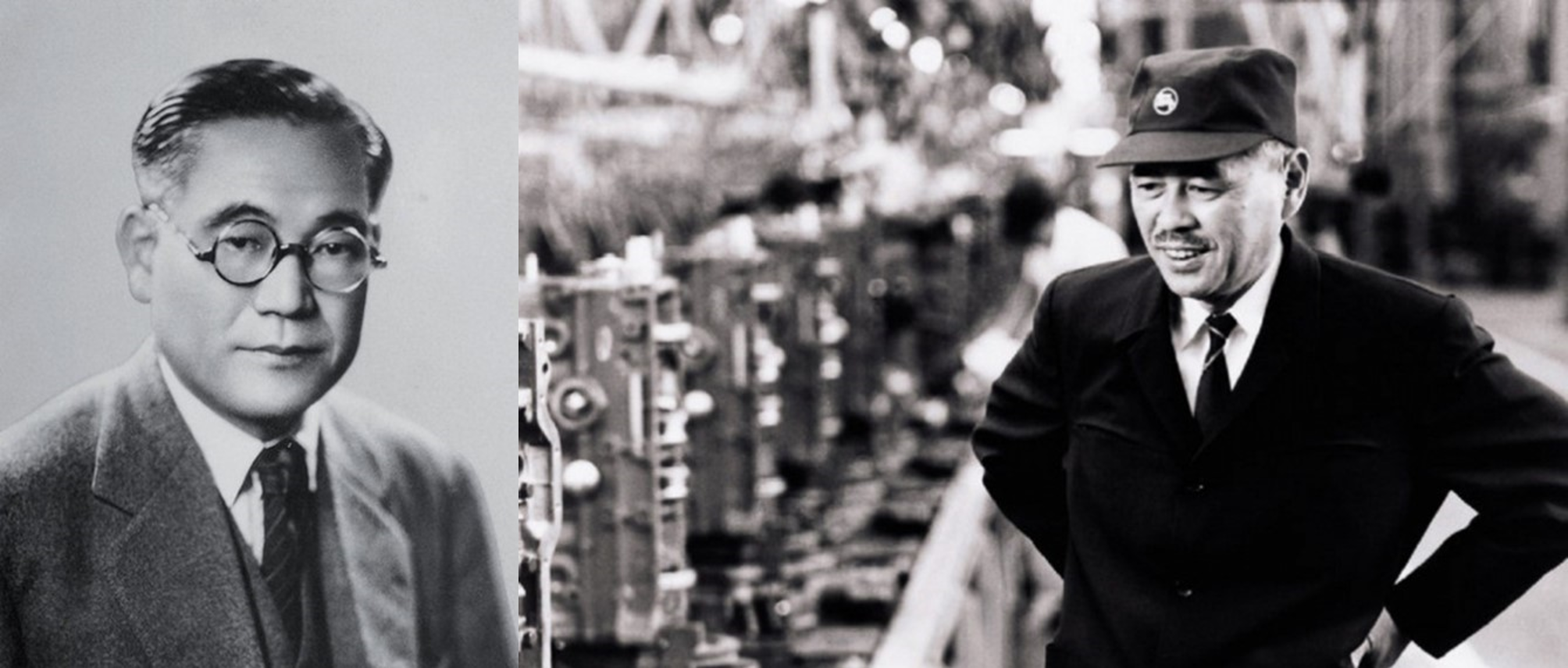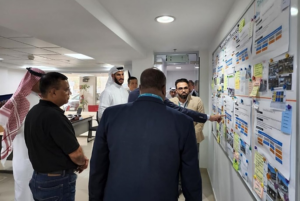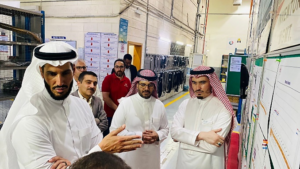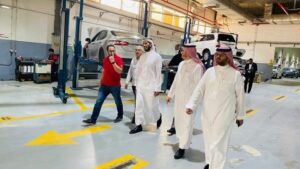A philosophy for better business . . . and a better life
The Toyota Motor Corporation Kaizen Team 2004 (Hassan Jameel is front row, second from the left)
A discussion with Hassan Jameel on Kaizen, and how small continuous improvement can add up to so much.
When Abdul Latif Jameel first partnered with Toyota nearly 70, years ago, it imported more than just cars. It also imported a whole new approach to managing a business.
The ‘continuous improvement’ approach as it is commonly known, is based on the Kaizen business philosophy pioneered by Japanese corporations like Toyota to boost efficiency and performance, eliminate waste and optimize the use of resources.
Henry Ford is credited with creating the first rudimentary lean manufacturing process, when he introduced a moving assembly line to his factories in 1913. However, it was the work of Kiichiro Toyoda, Taiichi Ohno and others at Toyota in the 1930s that refined and developed Ford’s original idea to create a true Lean Management and manufacturing system.
Using Ford’s methods as inspiration, they created the Toyota Production System – and sparked a revolution that, over the decades to come, transformed businesses in both Japan, the United States and beyond.

Kaizen, as the Japanese called this process of continuous improvement, originated in manufacturing processes. However, it can be equally applied to service businesses. Organizations adopting Lean Management assess every action and activity for potential improvements, no matter how small. Those gains may be minor in isolation but, taken together, add up to significant improvements that drive positive change.


Deputy President & Vice Chairman Saudi Arabia
Abdul Latif Jameel
Hassan Jameel, Deputy President and Vice Chairman, Saudi Arabia, Abdul Latif Jameel, is an ardent advocate of the Kaizen philosophy, having experienced it first-hand when working with Toyota, at their headquarters in Japan in the early 2000s.
We caught up with Hassan to discuss his interest in continuous improvement and how it helps organizations transform the way they do business.
What is ‘continuous improvement’? And what does it mean to you?
Unlike so much business jargon and consultancy terminology, the definition of continuous improvement is satisfyingly simple.
It’s right there, literally, in those two words. Always improving. Constantly trying to be better. On the surface, it sounds so obvious. But it’s deeper rooted than that.
Continuous improvement, to me as an individual, is not only about improving oneself every day. It’s about how you build that mentality into your lifestyle, so it becomes automatic. Every day thinking about what you could do to improve. It doesn’t matter how small, as long as you’re trying to improve something every day.
Then it becomes truly part of who you are. It’s similar in organizations. How do you create a culture that can consistently implement a continuous improvement approach in everything they do, every day, even if it’s the smallest change?
A culture that means that everyone in the business is continually thinking about their role, their team’s role, and the tasks they perform as part of their duties, and what little changes could be made to improve efficiency and quality. Each individual change might – at least at the time – seem inconsequential. But they all add up. Even the smallest incremental steps, when put together, make a big difference. I believe it’s simplicity that makes continuous improvement more effective and easier to understand.
When did you first become aware of the concept of continuous improvement?
I became aware of it when I was very young, even before I started working in the business. I would hear my father and other senior executives talking about it, and I was aware that it was something the business was doing, but I didn’t understand what it meant.

Continuous improvement is based on the ‘Kaizen’ business philosophy pioneered by Toyota.
Abdul Latif Jameel first came across it when it began importing Toyota vehicles into Saudi Arabia in the 1950s. But as a business philosophy, continuous improvement really rose to global prominence in the 1990s and 2000s. In 2001, Toyota – long seen as one of the pioneers of the concept – formalized its approach to Kaizen with the publication of the ‘Toyota Way’.
This hugely influential document became the blueprint for businesses around the world to understand more about continuous improvement and the benefits it could deliver.

It’s not necessarily Japanese, by the way. If you go to other big Japanese companies, you don’t necessarily hear Kaizen as much as when you go to Toyota. It was specifically Toyota who took these ideas and really turned them into a cohesive, practical business improvement philosophy around the concept of continuous improvement.
You spent time in Japan studying and working at Toyota earlier in your career. How did that influence your understanding of continuous improvement?
I spent high school and university in Japan, and I would often spend vacations working as an intern at Toyota, helping out on small projects here and there. It was only in 2004 when I joined Toyota’s domestic Kaizen division – the first non-Japanese person to do so – that I truly began to understand what was involved in continuous improvement at a practical level.
The role of the Kaizen division was to work with dealers in Japan and support them in implementing Kaizen projects, most of which were operational projects – supply chain, service related, inventory management, things like that. We’d work with them for several months to create and implement a continuous improvement process and, most importantly, make sure it would be sustainable after we left.

What did that involve and what did it teach you about continuous improvement?

It was a shock to the system!
I’d previously spent time in different working environments outside Japan where the word ‘Kaizen’ was used as vague shorthand for improving a task.
Some process wouldn’t be as efficient as it could be, and someone would say ‘you just need to Kaizen it!’, with no real understanding of what that meant at a deeper level.
When I was immersed in the Kaizen team in Japan, however, I realized there was a very precise, structured philosophy behind it.
The Kaizen approach is based on a whole set of principles that touch on virtually every aspect of a business’s culture and ways of working. At the process level, however – that is, when you want to improve a specific process – it all starts with data. That would be the first mission we had to accomplish.
We would stand in front of an operative, maybe someone on the car cleaning line, or in the service center servicing vehicles, for example. We’d have a stopwatch and a notepad, and we’d note down everything they did, along with the timings, during their working day. If they went to the bathroom, we’d make a note, if they had to walk across the garage to collect a tool, we’d note it down, if they had to go and find someone to ask a question, we’d note it down.

We’d do that for everyone involved in that task, so it might take us a week or more to collect all the data, which we would put into a giant spreadsheet – one for each worker. We’d hang these on the wall and go through them line by line and mark them up, using different colors to indicate whether it was wasted time, working time or unproductive working time.
I was only a trainee at this point, and I didn’t fully understand what we were doing. I said to my boss, what has this got to do with Kaizen? How will it make us more efficient?
He said, “Did you find any wasted time?” I told him that the individual had to leave his workstation two or three times to get some tools. He asked me, “How long did that take?” and I said, according to the data it took six minutes in total. He said, “How could you reduce that amount of time?” I suggested that if the operative had the tools next to him at his workstation, he wouldn’t need to cross the room to get them, so it would save six minutes. I was thinking, what difference is six minutes going to make! But he was thrilled. He explained that if we can save one technician six minutes in one day, that’s half an hour each week. If there are eight technicians doing this task, that’s a saving or four hours every week – over half a day. Multiply that over the year, and it’s a massive saving. How many more cars could be serviced in that time?
That’s when I really began to understand what continuous improvement was all about. It’s not about big, expensive ideas that someone at the top thinks is going to transform the workplace. It’s about small, incremental steps coming from the bottom up, that come together to make a real and meaningful difference that can be sustained.
Another job we worked on involved us repainting the stockyard for a dealer. We did it entirely ourselves over about 10 days. It was hard work! We were outside in the wind and the snow and the rain. I said to my boss, why don’t we just pay someone to come in and paint the stockyard? He explained that if we do it ourselves, we understand the process ourselves, and we understand how to improve it ourselves, so next year we can do it even better. If we pay someone else to do it, we can’t gain that knowledge.
The belief that it’s not about big ideas, but about small changes is very powerful, isn’t it? Sometimes in business, it’s easier to throw money at a problem than to deeply analyze what the true causes are.
That’s very true.
My boss once told me, if you want to solve a problem, don’t add to it . . . subtract from it.
What he meant was, if you identify a problem, don’t add more to it, like new processes, investment or technology. Instead, identify the waste or ‘muda’ (in Japanese), and multiply it by zero. That is, remove it. Once you take out all the waste and the unnecessary time, you pare it back to the clearest process – the ‘critical path’.
That gives you the foundation from which you can start trying to improve it incrementally.
It’s easy to see how continuous improvement applies to a big manufacturing business. Can it apply to smaller businesses or service businesses, too?

It can be applied to anything and everything we do in our lives.
Two of the methodologies explained in the Toyota Way are Genchi Genbutsu and Gemba. Both are about seeing for yourself where processes happen in the workplace, visiting the frontline, sitting with people, listening to them, understanding how they work and most importantly, why, so we can experience the problems ourselves.
That can be applied to an office environment as much as a workshop or a production line.
When I was at Toyota, we would work from the office one day a week. And we would see the boss walking around the office, sitting with the accounts team or talking to the operations guys, asking questions and making notes. That was Genchi Genbutsu in action – he was spending time with the people on the frontline so he could understand their processes and the issues they were facing.
Respect is a big part. Respecting our people, respecting our dealers, respecting our customers. Respect isn’t only about being nice and saying good morning and good evening to somebody.
It’s also about implementing policies, procedures, standards that create an environment of respect for people. Where they feel valued, where they feel responsible for their own performance and where they feel empowered to voice their opinions and share their ideas.
Of course, a key element of continuous improvement is about eliminating wastage, including time. And every business in every sector has wasted time, whether it’s unnecessary meetings, rambling reports, cumbersome bureaucracy. These are all examples of areas where a Kaizen approach can improve efficiency and productivity.
How has Abdul Latif Jameel tried to apply a continuous improvement approach in the workplace and what difference has it made?
At Abdul Latif Jameel, we have a whole program dedicated to Kaizen called ‘best in town’. It’s an initiative started by Toyota, and it’s called ‘best in town’ for a reason. The idea is that to be the best in your town, you need to know your local market very well, you need to fully understand your customers’ needs, and you need to consistently meet those needs in a much closer, more meaningful way than if you’re aiming to be ‘best in the world’ – which is a far more abstract goal, for example.
So, we have created this ‘best in town’ team to be the champions of continuous improvement within Abdul Latif Jameel; to help all our different businesses and locations understand the continuous improvement ethos and know how to embed it in their own operations. We’ve just had the regional ‘best in town’ 2023 conference in Saudi Arabia, with over 150 delegates from ‘best in town’ teams across the world to share their insights, experiences and successes with continuous improvement from a wide variety of businesses and industry sectors.




How has the initiative been received within Abdul Latif Jameel?
Extremely positively, and not just by management, but more importantly for me, by the people who really matter – the people on the front line who are responsible for responding to the needs of our customers and clients every day.
When I visit a location that ‘best in town’ hasn’t reached yet, I get people coming over and asking me when it’s coming, because they’ve heard such positive things about it.
Going forwards, how can this mindset of continuous improvement help Abdul Latif Jameel in its continuing success?
Our objective as a business is to make sure our culture is one that believes in and acts on continuous improvement in perpetuity.
That’s very difficult to achieve, but if we can build a culture within Abdul Latif Jameel whereby continuous improvement is the default mindset; an automatic approach that everybody follows without even thinking about it; led by a generation of leaders who are brought up with this way of thinking, that will be a very powerful proposition.
We’re not there yet, but that’s what we’re striving for.
As a young man, you went to Toyota in Japan, and you were immersed in the Kaizen culture. How has it changed the way you look at life?
Fundamentally, Kaizen is such a simple way of looking at life. That’s how it has affected me most. I try to keep things as simple as they can be, because once you complicate things, the solutions also become more complicated. It starts with small things, like making your bed every morning. If you do that, then you’re starting the day with a first small piece of success.
It also taught me that you must always strive for improvement in yourself and be humble about it.


I remember my father once having dinner with Dr Shoichiro Toyoda, the founder of Toyota.
They were talking about the ‘Toyota Way’ and my father asked him, “what does it mean to you?” And Dr Toyoda responded: “I’m still learning.”
Later, I reflected on what that meant, and it really struck me.
What it means is humility . . . Being aware – and humble enough – to appreciate that everyone can always learn and improve; it means understanding this deeply, and so continually moving forwards – which is very the essence of Kaizen.

In fact such is Abdul Latif Jameel’s commitment to continuous improvement, that in 2017 we entered a joint venture with ‘Lean Management’ consultancy, Four Principles, to spread the ideas across the Middle East region and beyond, helping both private and public sector organizations leverage the opportunities it can deliver.





 1x
1x

 Added to press kit
Added to press kit


